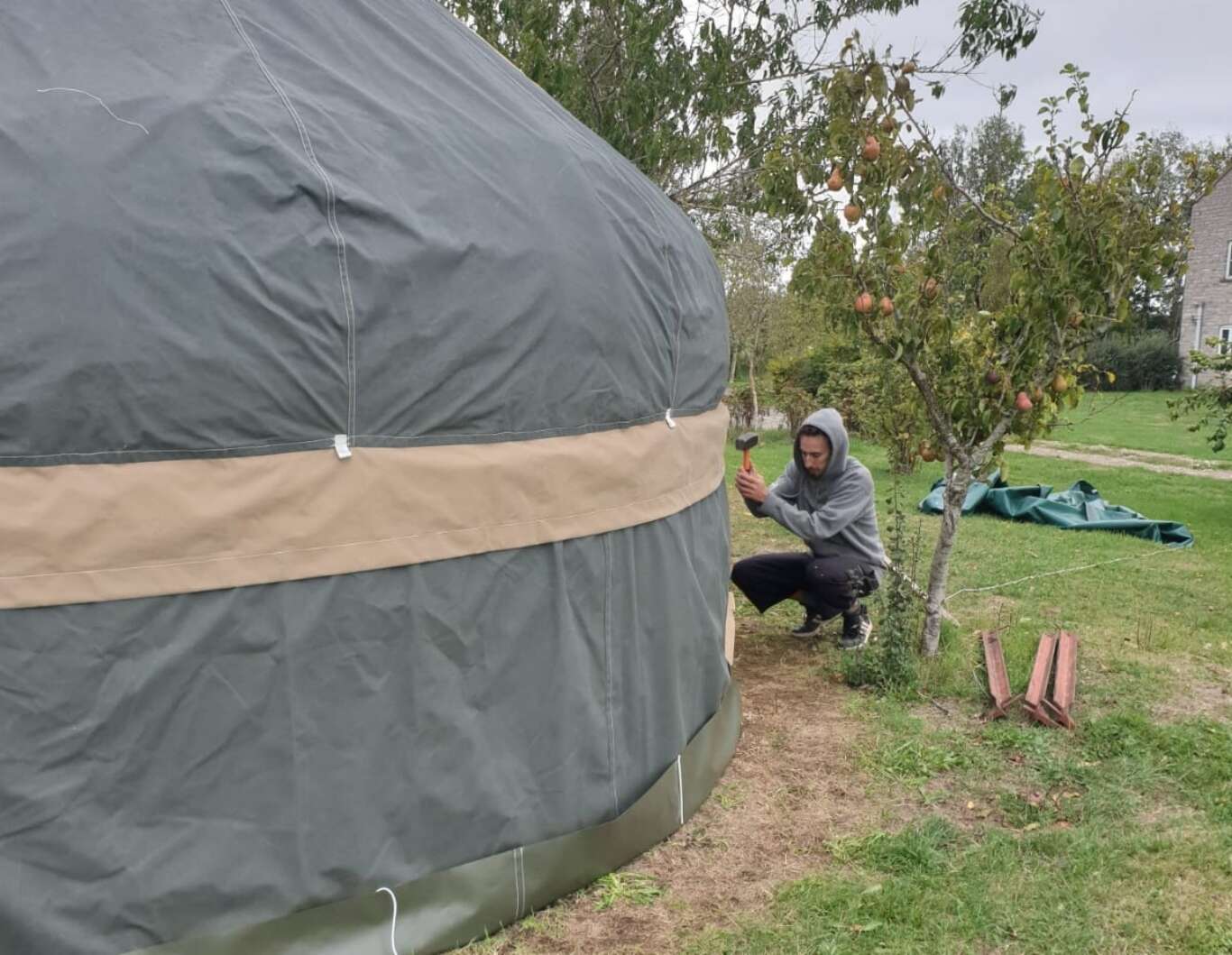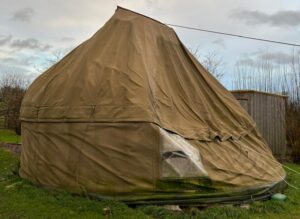
Maintaining your Hearthworks Yurt
This guide provides instructions on how to properly maintain your Hearthworks Yurt to ensure it lasts for many years. Regular maintenance will help to protect your yurt from the elements and prevent minor issues from becoming major problems.

General Maintenance Advice
Inspect for Holes or Tears: Routinely check the canvas for any signs of wear and tear or visible damage. Small holes and rips in the canvas are best dealt with as soon as they appear, preventing escalation of the issue and saving you unnecessary expense.
Clean the Canvas: Regularly brush off dirt and debris from the canvas, especially after storms. You can use a soft brush or hose down the canvas on a dry, sunny day. Avoid using harsh chemicals or scrubbing too aggressively to prevent damage to the canvas’s protective layer.
Cleaning PVC Windows: Vinyl windows are the most delicate part of your yurt. The surface is easily scratched, so when cleaning, use soapy water and a soft cloth, ensuring all soap is rinsed off. Specialist plastic polish can be used to remove small scratches and improve the appearance. We recommend rolling windows rather than folding them, as folding can create creases and small tears.
Ventilation: Adequate ventilation is key to reducing moisture buildup and preventing mould and mildew. If your yurt isn’t used for long periods of time, we recommend you continue to regularly vent and heat the structure.
Wood Care: With careful maintenance of the yurt frame, it should last for decades. The frame and door should be periodically checked for any signs of wear or rot, particularly if the yurt is in a humid or damp environment. Clean and treat the wooden elements with an appropriate wood care product every year to maintain their resistance to moisture and prevent deterioration.
Canvas Care Guide
Cleaning: Leaves or organic debris left on the canvas can stain the colour and prematurely age the cover. Gently brush any debris off the roof cover. For bird excrement or spot cleaning marks, the canvas of your yurt can be cleaned with a mild soap and water solution. Be sure to rinse the canvas thoroughly and allow it to dry completely before storing it. Avoid using harsh chemicals or detergents, as these will damage the canvas.
Mould and Mildew: If you discover mould or mildew on your yurt canvas, you can treat it with a solution of one part vinegar to three parts water. Apply the solution to the affected area and scrub gently with a soft brush. Allow the canvas to dry completely before storing it.
Waterproofing: With seasonal use, you can expect your canvas to retain its waterproof treatment indefinitely, until the whole canvas needs replacing. For year-round use, this time is reduced to between 7 and 10 years. You can re-waterproof the canvas using a commercially available canvas waterproofing product. Be sure to follow the instructions on the product label carefully.
Industrial Cleaning: We don’t recommend getting your yurt cover industrially cleaned. This is an aggressive process that strips the canvas of all finishing treatments and affects the canvas colour, often without removing the staining for which the cleaning was intended. It is much more cost-effective to have a regular maintenance schedule to keep the canvas in the best condition for as long as possible.
Frame and Door Care Guide
Preventing Rot: Ensure the yurt’s base is elevated off the ground to avoid direct contact with moisture; the wall trellis should sit inside the groundsheet upstand. If you notice any signs of mould or mildew on the frame, clean with a mild soap solution and allow it to dry completely.
Inspection: Periodically inspect the frame for any cracks or signs of wear. If any parts of the frame appear weakened, it may be time for a professional evaluation or to purchase the required replacement parts.
Cleaning and Treatment: Keep the frame and door clean by wiping them down with a damp cloth to remove dust or dirt. The exterior door should be re-treated every year. Lightly sand the door and treat the wood with a protective sealant or preservative to prevent rot and preserve its integrity. The same advice applies to the frame, although without UV exposure, the frequency may be reduced.
Over-wintering Your Yurt
Ventilation: Condensation occurs when moisture accumulates on cold surfaces. Regular ventilation by opening the door is required to allow air circulation and minimise the buildup of moisture.
Heating Systems: A woodburner is the best way to heat a yurt, providing lots of dry heat. Light your burner regularly throughout winter and during periods when the yurt is vacant. If you use a portable heater, ensure it is well-maintained and safe to use in cold weather. Also, keep ventilation open to prevent a buildup of moisture.
Storage: If your yurt is for seasonal use and you intend to store it during the colder months, ensure all parts are clean and fully dry before storage. The location should be cool, dry, and secure from rodents.
Canvas Insulation: If your yurt remains up during winter, consider adding a yurt insulation liner to help keep the heat in and protect the canvas from extreme cold. Ensure the insulation is properly installed to avoid condensation issues.
Snow Load Management: Heavy snowfall can accumulate on the roof of your yurt. Prolonged periods of excess load can cause the roof frame to twist and warp permanently. Gently sweep the roof to remove snow regularly, or heat the interior to stop the snow settling.
Storm Preparation
Check Stability: Ensure that all the guy ropes and tensioning lines are tightly secured and that the yurt is properly anchored to the ground. This will help prevent damage during storms.
Clear the Area: Remove any objects near the yurt that could potentially fly around and damage the canvas or structure in high winds. This includes outdoor furniture, branches, or debris.
Temporary Reinforcements: For particularly strong storms, we recommend you temporarily add extra straps, stakes, or tie-downs to reinforce the structure.
Replacement Parts
In time, certain parts of your yurt may need to be replaced to keep it functioning at its best. Hearthworks manufacturing experts can make replacement parts for all components of your yurt, even if it was originally purchased elsewhere.
Star Dome: From our experience, we have found the star dome is often the first part that will need replacing due to UV damage and occasionally from poor ventilation leading to mould. You can request a replacement star dome from us.
Windows: PVC windows can be damaged by improper storage, folding, or the use of harsh detergents on their surface. We can replace windows without needing to replace the whole wall, provided the canvas still maintains its structural integrity.
Canvas Replacement: UV and moisture are the biggest degraders of canvas. We use a cotton and polyester blend canvas to extend its life versus pure cotton. However, once the canvas becomes severely worn or damaged beyond repair, you can purchase a replacement custom-made to fit your specific yurt model.
Frame Components: Should a part of the wooden frame become damaged or show signs of rot, replacement pieces are available, including the ring, roof poles, wall trellis sticks, and door components.